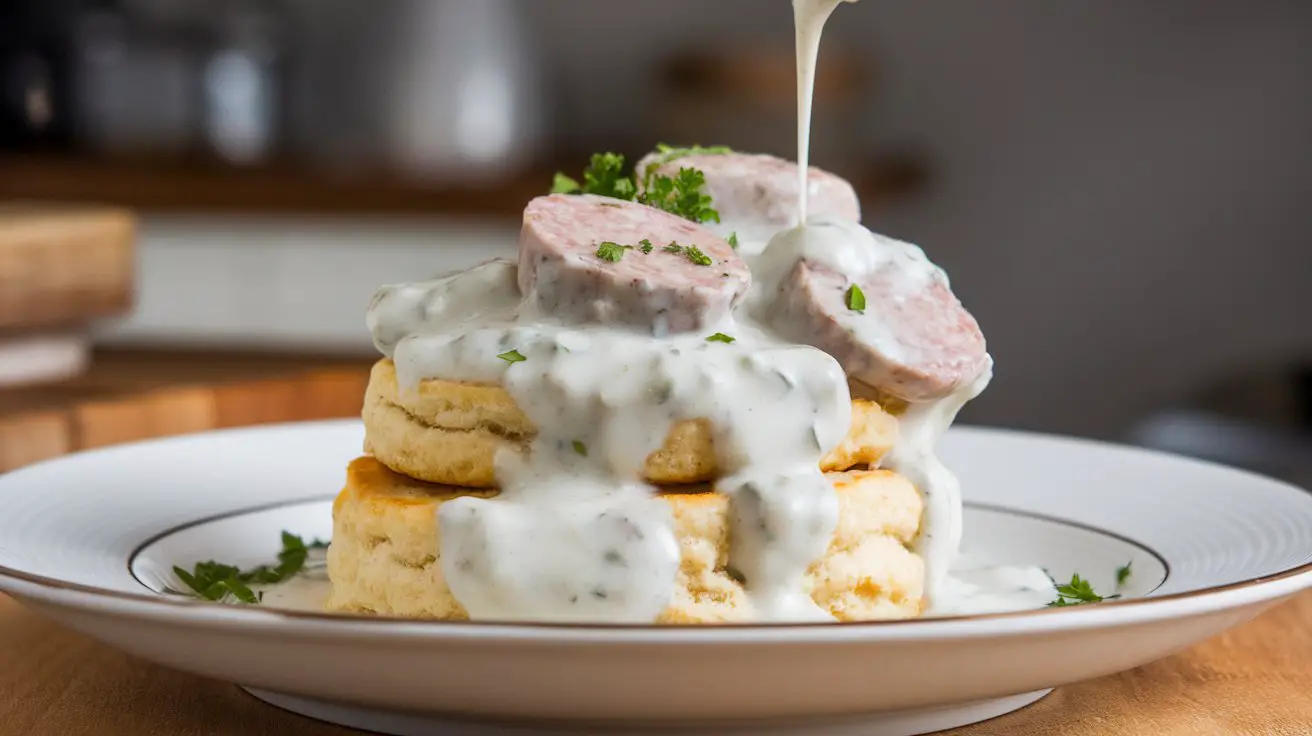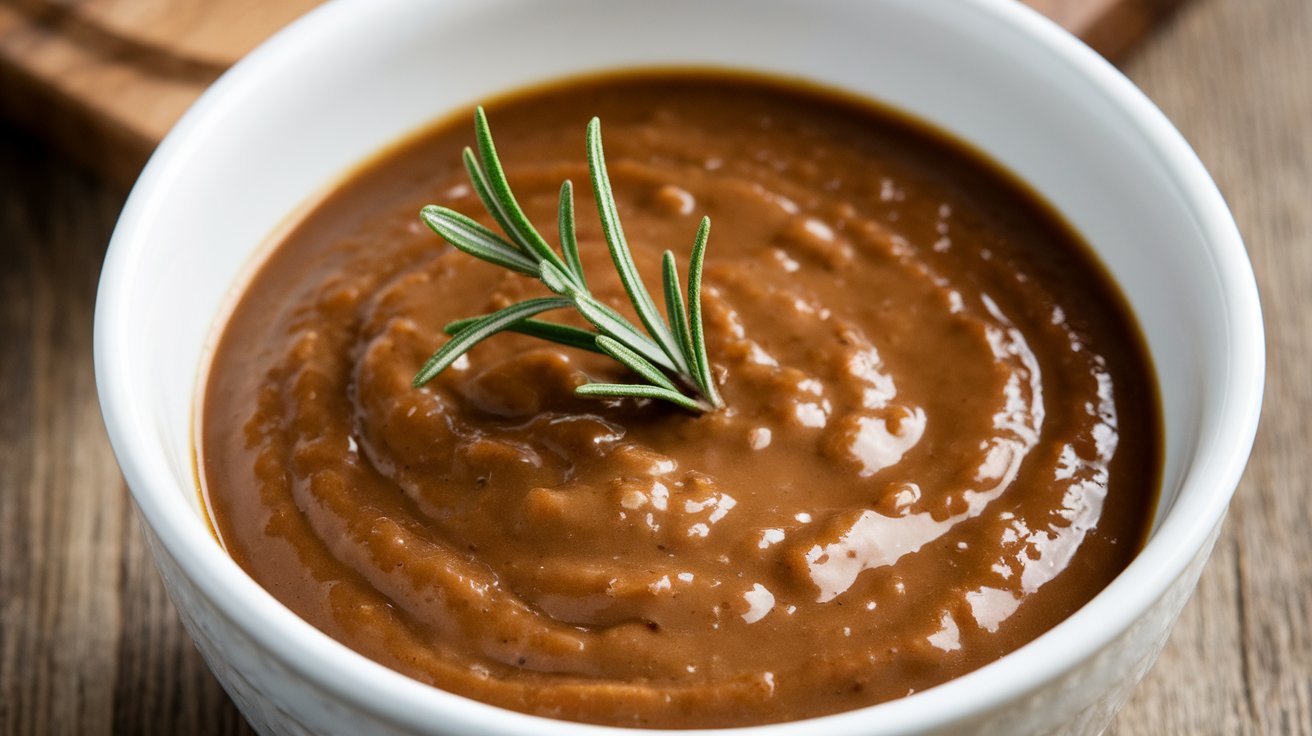Gravy—it’s the unsung hero of comfort food. Whether it’s poured over mashed potatoes, turkey, or biscuits, gravy has a magical ability to tie a meal together. But let’s face it: not all gravy is created equal. Some end up lumpy, too salty, or (worst of all) bland. So, what’s the secret to good gravy? Let’s dive in and uncover all the tips, tricks, and secrets to making gravy that’s so good, people will want to drink it straight from the bowl. 😄
Introduction to Gravy: A Culinary Staple
Gravy isn’t just a sauce; it’s a tradition. Across kitchens around the world, gravy has been a mealtime staple for generations. From Thanksgiving feasts to Sunday roasts, it’s the element that takes your meal from “meh” to memorable.
Why does gravy hold such an iconic status? Well, it’s like the glue that binds a meal together. Without gravy, roasted meats or mashed potatoes can feel incomplete—like peanut butter without jelly. But getting gravy just right can feel like a daunting task, especially if you’re new to cooking. Don’t worry, though. By the time you finish reading this, you’ll be a gravy pro!
The Basics of Gravy: Key Ingredients
To make exceptional gravy, you need to master the basics. Think of it like building a house: you need a solid foundation. The good news? The essential ingredients are simple, but the magic lies in how you combine them. Let’s break it down. 🛠️
Choosing the Right Fat: Butter, Drippings, or Oil
Gravy starts with fat, and the type you choose can dramatically change the flavor. The most common fats are:
- Butter: Rich and creamy, great for white gravies.
- Meat Drippings: The holy grail of flavor, extracted from roasted meat like turkey, chicken, or beef.
- Vegetable Oil: A neutral option for those seeking a lighter base.
Pro Tip: Always save the drippings when roasting meat! They’re a goldmine for flavor. If you don’t have enough, you can supplement with butter or oil.
The Importance of Flour or Starch in Thickening
What makes gravy thick and luscious? It’s the magic of a thickening agent like flour or cornstarch. Flour is traditional, while cornstarch works well for gluten-free options.
- Use flour if you want a hearty, opaque gravy.
- Go for cornstarch if you prefer a clear and glossy finish.
Here’s a quick ratio to remember: For every cup of liquid, you’ll need about 1 to 2 tablespoons of flour or starch.
Stock and Broth: The Heart of Flavor
No stock? No gravy! Your liquid base is where most of the flavor comes from, so don’t skimp. You can use:
- Homemade stock for maximum richness.
- Store-bought broth in a pinch.
- Or even just water with bouillon cubes.
Pro Tip: Combine beef and chicken stock for a deeper, more complex flavor.
Here’s a simple chart for basic gravy ingredients:
| Ingredient | Quantity | Purpose |
|---|---|---|
| Fat (butter/drippings) | 2–3 tablespoons | Adds richness and body |
| Flour or Cornstarch | 2 tablespoons | Thickens the gravy |
| Stock/Broth | 1 cup | Provides the liquid base |
| Salt and Pepper | To taste | Enhances the overall flavor |
Common Problems in Gravy Making and Their Solutions
Even seasoned cooks can face challenges when making gravy. But don’t stress—it’s all fixable! Let’s look at some common pitfalls and how to solve them. 🔧
Lumpy Gravy: Causes and Fixes
Nobody likes gravy that looks like it’s full of tiny dumplings. The main culprit? Adding flour directly to hot liquid.
How to Fix It:
- Whisk like your life depends on it! A wire whisk is your best friend here.
- Use a blender if the lumps are stubborn.
- To avoid lumps entirely, make a roux (a cooked mixture of fat and flour) before adding the liquid.
Quick Fix: Strain the gravy through a fine mesh sieve if all else fails.
Too Thin or Watery Gravy: How to Thicken Properly
Thin gravy feels like a missed opportunity. If your gravy isn’t thickening, you might have added too much liquid or skipped the thickening agent.
Solutions:
- Make a slurry: Mix 1 tablespoon of cornstarch with 2 tablespoons of cold water, then whisk it into the hot gravy.
- Simmer it longer: Let the gravy reduce over low heat to naturally thicken.
Pro Tip: Avoid adding too much slurry at once, or you’ll risk over-thickening.
Overly Salty Gravy: How to Balance Flavors
Uh-oh. Did you get a little heavy-handed with the salt? It happens to the best of us. Here’s how to salvage your gravy:
- Add a splash of cream or milk to dilute the saltiness.
- Stir in a mashed potato (yes, really!) to absorb some of the salt.
- Increase the overall volume by adding more unsalted broth.
Pro Tip: Always taste your gravy as you go. Salt is easy to add but hard to take away!
Gravy Lacking Depth of Flavor: Adding Umami
Ever tasted gravy that’s… meh? If it’s bland, you need to dial up the umami. Try these:
- A splash of soy sauce or Worcestershire sauce.
- A pinch of MSG (it’s safe, we promise!).
- A dollop of tomato paste.
“Good gravy is like a good story—it needs a strong start, a rich middle, and a satisfying finish.”
Techniques for Making Perfect Gravy
Making gravy isn’t rocket science, but it does require some technique. Follow these steps for foolproof results every time. 🚀
The Roux Method: Step-by-Step Guide
A roux is the foundation of most classic gravies. Here’s how to make one:
- Melt 2 tablespoons of fat (butter or drippings) in a pan over medium heat.
- Whisk in 2 tablespoons of flour until it forms a paste.
- Cook for 1–2 minutes to eliminate the raw flour taste.
- Gradually add stock, whisking constantly, until smooth.
Pro Tip: Want darker gravy? Cook the roux longer until it’s golden brown.
Deglazing the Pan: Extracting Maximum Flavor
Ever noticed those browned bits stuck to the bottom of a roasting pan? That’s concentrated flavor just waiting to be unleashed. To deglaze:
- Remove the roasted meat and set the pan over medium heat.
- Pour in a splash of stock, wine, or water.
- Scrape up the browned bits with a wooden spoon.
Pro Tip: Deglazing with wine adds complexity, but use it sparingly.
Adjusting Seasoning Like a Pro
Taste, adjust, repeat. This mantra will help you get the perfect balance of salt, pepper, and spices. Don’t be afraid to get creative with flavors—add herbs like thyme or rosemary for an earthy twist.
The Science Behind a Perfect Gravy
Why does some gravy turn out silky smooth while others feel grainy or separate entirely? The secret lies in understanding the science behind it. Don’t worry—I won’t bore you with a chemistry lecture. Let’s keep it simple and fun! 🌟
Understanding Emulsification and Consistency
Gravy is essentially an emulsion—a harmonious blend of fat and liquid. To achieve that velvety texture, you need to keep these elements in balance:
- Fat binds the gravy: It gives the sauce richness and sheen.
- Liquid stretches it: This ensures the gravy isn’t too heavy or greasy.
Ever wonder why your gravy splits? It’s because the fat and liquid don’t fully combine. The key to avoiding this is constant whisking while adding the liquid gradually.
“Think of whisking like matchmaking—you’re helping two opposites (fat and water) come together in perfect harmony.”
The Role of Heat and Timing in Gravy Success
Temperature control is everything when it comes to gravy. Too hot, and your gravy could curdle. Too cold, and you’ll end up with clumps. The sweet spot? Medium heat.
Timing also plays a big role. Cook the roux just enough to remove the raw taste, but don’t rush when adding the liquid. The slower you go, the smoother your gravy will be. And patience? It’s your secret weapon.
Variations of Gravy Around the World
Gravy isn’t just a one-size-fits-all sauce. It comes in all kinds of flavors and styles depending on where you are in the world. Let’s take a mini culinary tour! ✈️
Classic Brown Gravy
This is your go-to gravy for Thanksgiving turkey or roast beef. It’s made from meat drippings, flour, and stock, delivering that hearty, umami-rich flavor everyone loves.
Creamy White Gravy (Sausage Gravy)
A Southern favorite, this gravy is made with milk or cream, flour, and usually crumbled sausage. It’s perfect for smothering biscuits on a lazy Sunday morning.

Vegan and Vegetarian Gravy Options
No meat? No problem. Vegetable-based gravies can be just as flavorful. Use:
- Mushroom stock for depth.
- Nutritional yeast for a cheesy note.
- A splash of soy sauce for umami.
Pro Tip: Blend roasted veggies into the gravy for extra flavor and thickness.
Tips from Professional Chefs for Amazing Gravy
Ever wonder how chefs whip up restaurant-quality gravy? Here are some insider secrets you’ll want to steal. 🧑🍳
Secret Ingredients to Elevate Gravy
- A splash of wine or sherry: Adds a touch of elegance.
- A spoonful of Dijon mustard: Brightens the flavor.
- A hint of maple syrup or honey: Balances salty and savory notes.
Chef’s Wisdom: “Gravy is like a blank canvas—don’t be afraid to experiment with bold flavors!”
Time-Saving Hacks for Busy Cooks
- Use a premade stock base if you’re short on time.
- Make gravy ahead of time and reheat—it tastes even better after sitting for a while.
- Keep a jar of roux in your fridge for quick thickening.
Serving and Storing Gravy: Best Practices
You’ve mastered the art of gravy. Now, let’s talk about serving it hot and keeping leftovers fresh. 🍽️
Reheating Gravy Without Compromising Quality
The biggest challenge when reheating gravy is avoiding separation. Here’s how:
- Use low heat and stir frequently.
- Add a splash of stock or water if it gets too thick.
Pro Tip: Never reheat gravy in the microwave—it’s a recipe for disaster.
Freezing Gravy: Dos and Don’ts
Gravy freezes beautifully, making it a lifesaver for future meals. But there’s a trick to it:
- Let it cool completely before freezing.
- Store it in an airtight container or freezer bag.
- Thaw it slowly in the fridge overnight.
Quick Tip: Freeze gravy in ice cube trays for portioned servings. Perfect for single meals!
Nutrition Facts and Sample Recipe
Let’s talk about what’s actually going into your gravy. Here’s a breakdown of basic nutrition facts and a simple recipe to get you started.
Nutrition Facts for 1 Cup of Classic Gravy
| Nutrient | Amount |
|---|---|
| Calories | ~100 kcal |
| Fat | ~6 g |
| Carbohydrates | ~8 g |
| Protein | ~2 g |
| Sodium | ~300 mg |
Simple Gravy Recipe
| Ingredient | Quantity |
|---|---|
| Fat (butter/drippings) | 2 tablespoons |
| Flour | 2 tablespoons |
| Stock/Broth | 1 cup |
| Salt and Pepper | To taste |
| Optional Add-Ins | Soy sauce, herbs |
Instructions:
- Melt the fat in a pan over medium heat.
- Whisk in the flour and cook for 1–2 minutes.
- Gradually add stock while whisking constantly.
- Simmer until thickened, about 5 minutes.
- Season with salt, pepper, and optional add-ins.
“Good gravy isn’t just a sauce—it’s a love letter to your taste buds.”
Conclusion: Unlocking the Secret to Good Gravy
Gravy isn’t rocket science, but it is an art form. With the right ingredients, techniques, and a dash of creativity, you can whip up gravy so good it’ll have your family begging for seconds (or thirds). Remember, practice makes perfect, so don’t be afraid to experiment.
Now it’s your turn—roll up your sleeves, grab that whisk, and start making some magic in the kitchen. Who knows? You might just discover your own secret to good gravy. 😊

